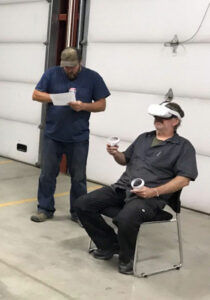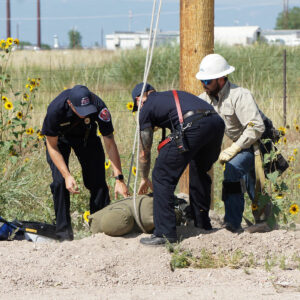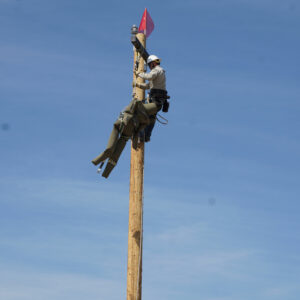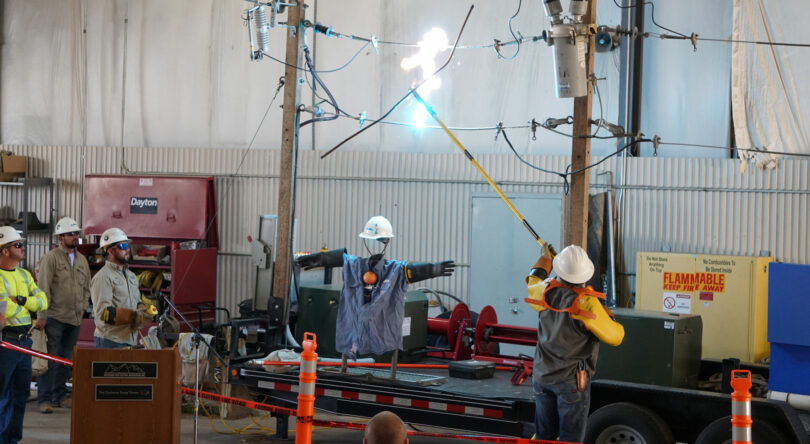An arc of electricity flashes through the air and captures the attention of first responders as they gather to watch a power line safety demonstration put on by Morgan County Rural Electric Association linemen.
Mounted on a flatbed trailer, the 7,200-volt “Hotline” demonstration was designed and built by MCREA linemen to show what happens when someone comes in contact with a power line, said Maddie Pollart, MCREA communications and public relations coordinator. The co-op also has a tabletop version — useful for demonstrations in schools and other venues. “We can give [the training] to anybody — classrooms, neighboring businesses, the Rotary Club, for example — but we especially enjoy presenting to our local first responders,” Pollart said.

Morgan County REA trains first responders in Washington County with virtual reality headsets that simulate downed power lines and other emergency situations. Photo courtesy of Morgan County REA.
The Fort Morgan-based co-op’s demo uses hot dogs and oranges to simulate what happens to a person’s inner organs after coming in contact with a live, energized line. “Typically, people are amazed,” Morgan County REA Line Superintendent Travis Varelman said. “They don’t understand the potential damage of an electrical contact. Aside from immediate consequences, an electrical contact can have long-term effects. It can take years for symptoms to arise.”
Mountain View Electric Association, with offices in Falcon and Limon, also has two high-voltage demo trailers that its linemen use to replicate different power line safety scenarios. The co-op also holds a live-wire and first responder event every few years at its Falcon office to show potential consequences of electrocution on the human body and heart. Using a dummy prop attached to the top of a power pole, linemen demonstrate how to rescue in just minutes a fellow lineworker who has come in contact with electricity, said Sara Muirheid, MVEA communications supervisor.
“Safety is our top priority,” Muirheid said. “We want our first responders to know what to do in the first few seconds at the scene of an accident that involves electricity; it could make the difference between life or death for both victims and for first responders.”
At Poudre Valley REA in Fort Collins, Working Foreman Kelly Streeb conducts four-hour safety demonstrations for both law enforcement and firefighters. The trainings are hands-on and include a PowerPoint presentation, tabletop demos, and opportunities to learn how to operate high-voltage detective tools to mitigate hazards before other emergency responders arrive, said Streeb. They practice what to do in emergency situations.
“We set aside a budget each year to cover emergency responder training needs,” Streeb said. “We want to do our part to keep emergency responders and the public safe. Departments can get a hold of our safety director to schedule a class.
“We have spent a week at departments doing trainings,” Streeb continued. “Some have several stations and crews. PVREA provides trainings for approximately 20 different departments. We do advanced training and continual education with our lineworkers as well.”
TECHNOLOGY AND TRAINING
In addition to tabletop demos and hotline trailers, MCREA uses virtual reality headsets for an immersive training experience that simulates various emergency situations. MCREA learned about the high-tech headsets from an Oregon electric co-op’s success with the tool. After borrowing one of their VR headsets to see how it worked, the co-op purchased three of its own.
One of the VR training experiences is geared toward first responders, while a second video simulates a farm or ranch scene where users see the dangerous implications of stacking hay under power lines and to check clearances when moving long pieces of irrigation pipe. “It’s very real,” Pollart said. “VR demonstrations have a significantly higher retention rate when compared to reading or lectures. They drive home the point; they’re easy to remember.”

Mountain View Electric Association linemen use a dummy prop to demonstrate a power pole rescue scenario with local first responder teams. Photos courtesy of Mountain View Electric Association.
WORKING TOGETHER
Durango-based La Plata Electric Association tries to meet with emergency management officers monthly to discuss emergency action plans and hazard mitigation techniques, said Jerry Sutherlin, LPEA vice president of operations. “We have worked together to perform tabletop demonstrations, going over different scenarios, weather conditions, and testing of our local radio systems — which is how we can all work together,” he said.
LPEA also has a newly constructed high-voltage demo trailer that it uses for first responder training. “Many policemen and firemen don’t realize the hazards associated with electricity,” Sutherlin said. “A lot of times, if there’s been a car accident, they will be the first on the scene. We educate about the hazards if there are power lines involved. Everybody’s lives are important. They offer trainings for us, as well,” he said, regarding fire extinguishers, or dealing with active shooters.
“The biggest safety issue we see regularly is inclement weather — trees and branches that fall through power lines,” Sutherlin said. “We live in such a forested area — those events are not uncommon. We don’t want first responders to assume a line is de-energized,” Sutherlin continued. “If they want to move a line to free up traffic, our message is ‘stay away’ until we get there.” Sharon Sullivan is a freelance journalist based in Grand Junction. She writes for a variety of magazines, newspapers, and nonprofit organizations. When not working she’s likely to be out hiking the public lands surrounding the Grand Valley.


